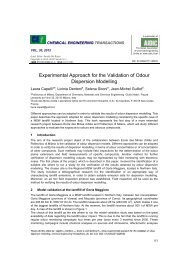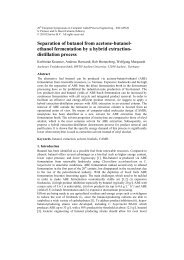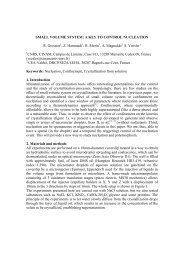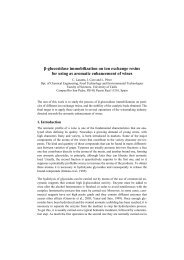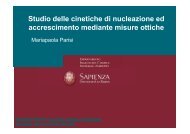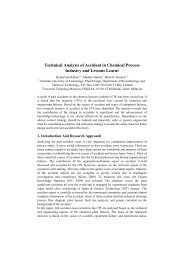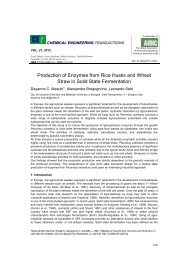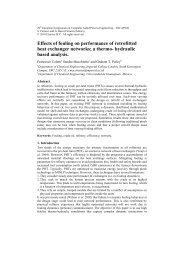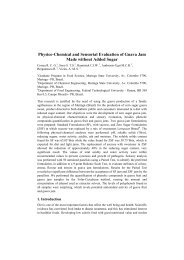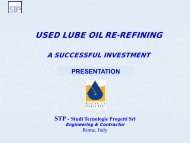Life Cycle Assessment to Municipal Wastewater Treatment ... - Aidic
Life Cycle Assessment to Municipal Wastewater Treatment ... - Aidic
Life Cycle Assessment to Municipal Wastewater Treatment ... - Aidic
You also want an ePaper? Increase the reach of your titles
YUMPU automatically turns print PDFs into web optimized ePapers that Google loves.
<strong>Life</strong> <strong>Cycle</strong> <strong>Assessment</strong> <strong>to</strong> <strong>Municipal</strong> <strong>Wastewater</strong><br />
<strong>Treatment</strong> Plant<br />
Jessica Sarai García Alarcón 1 , An<strong>to</strong>nio Rodríguez Martínez 2 * , Israel Herrera Orozco 3<br />
1<br />
Posgrado en Ingenieía y Ciencias Aplicadas, Universidad Autónoma del Estado de<br />
Morelos<br />
Av. Universidad 1001 Colonia Chamilpa Cuernavaca, Morelos, México C.P. 62209,<br />
an<strong>to</strong>nio_rodriguez@uaem.mx<br />
2<br />
Centro de Investigaciones en Ingeniería y Ciencias Aplicadas. Universidad Autónoma<br />
del Estado de Morelos, México.<br />
3<br />
Departameno de Energía, Centro de Investigaciones Energéticas, Mediambientales y<br />
Tecnologicas.<br />
This analysis is a partial study of inven<strong>to</strong>ry over a <strong>Wastewater</strong> <strong>Treatment</strong> Plant (WTP),<br />
and establishing the main impacts in the <strong>Life</strong> <strong>Cycle</strong> of municipal wastewater treatment<br />
systems with the application of <strong>Life</strong> <strong>Cycle</strong> <strong>Assessment</strong> (LCA) according with ISO<br />
14040 and ISO 14044. The results showed, in the inven<strong>to</strong>ry assessment, an important<br />
decreasing in the Biochemical Oxygen Demand and Total suspends solids (75 and 77<br />
percent, respectively). On the other hand, it was observed a reduction in Eco<strong>to</strong>xicity<br />
category in the impacts assessment stage. Finally, consumption of additive and energy<br />
as well as the generation waste do not imply in a considerable increase of other impacts.<br />
1. Introduction<br />
Although there are his<strong>to</strong>rical references from ancient times, the problem of pollution of<br />
water has reached peak levels in recent times. It seriously jeopardizes the future of<br />
humanity not only due <strong>to</strong> the large industrial growth, also because of the demographic<br />
trends. The problem is accentuated by the merger, both industrial and human in<br />
narrowly defined areas, it is determined that the world population majority nowadays is<br />
urban (Pierre, 2009; Renou, 2008). There are many aspects and methodologies for<br />
assessing the problem of pollution of water, so that all environmental burdens are taken<br />
in<strong>to</strong> account when framing the real solutions that meet the needs of potable water supply<br />
(Sainz, 2007). LCA is defined as a compilation and evaluation of the inputs, outputs and<br />
the potential environmental impacts of a system throughout its life cycle: from the<br />
production of raw materials <strong>to</strong> the disposal of the waste generated. (ISO, 2006)<br />
2. Definition of Objective and Scope<br />
2.1 Context<br />
This study has been based on data reported by the plant. In cases where it was<br />
impossible <strong>to</strong> count with data from the plant, data were taken from the literature and
Ecoinvent ® database (Frischknech et al, 2007). The aim of this preliminary study was <strong>to</strong><br />
identify environmental impacts and <strong>to</strong> propose alternatives for its reduction (ISO 14040,<br />
ISO 14044).<br />
2.2 Objective and scope<br />
The main objective of this work is <strong>to</strong> apply <strong>Life</strong> <strong>Cycle</strong> <strong>Assessment</strong> (LCA) <strong>to</strong> WTP using<br />
SIMAPRO ® ver. 7.0, <strong>to</strong> determine the environmental impacts, realizes a comparison of<br />
several scenarios and proposes improvements.<br />
The Figure 1 shows the system and its boundaries. The system <strong>to</strong> be analyzed in this<br />
paper is a treatment plant for municipal wastewater and the influent of the plant from<br />
the entrance <strong>to</strong> it, even before discharge <strong>to</strong> the receiving body.<br />
Figure 1: System description and its boundaries.<br />
3. Inven<strong>to</strong>ry Analysis<br />
3.1 Hypothesis and limitations<br />
In the wastewater treatment plant scenery, the data for sludge production and chlorine<br />
consumption by the plant have been obtained from a plant with similar characteristics<br />
because there is no data reported by the WTP. Three values from literature were used<br />
for the production of sludge and also for chlorine consumption, in order <strong>to</strong> compare<br />
between the possible consumption and its impact on the analysis (Sainz, 2007). In the<br />
case of electricity consumption data was obtained through an approximation,<br />
considering all electricity consuming equipments.<br />
3.2 Data sources<br />
Most of data used in this analysis are data reported by the plant, except <strong>to</strong>tal nitrogen,<br />
sludge production, electrical and chlorine consumption. For other compounds, were<br />
assumed constant during treatment, this is because the water treatment process does not<br />
represent any change on these components except for nitrites.
4. Results<br />
4.1 LCA Inven<strong>to</strong>ry results<br />
In Tables 1 and 2 are showing the inven<strong>to</strong>ry results of two scenarios analyzed and the<br />
results of linkage of this data with the functional unit. Bibliographic data used for the<br />
development of this assessment are for the electrical consumption 3.6489 KWh/m 3 , for<br />
chlorine consumption 0.02 Kg/m 3 and sludge production 8.28E-09 Kg/m 3 . Total<br />
nitrogen has a value between 30-60 ppm (Sainz, 2007).<br />
Table 1: Reference scenery. Stream before treatment<br />
[L/s] [mg/L]<br />
Day Q DQO DBO5 N <strong>to</strong>t.<br />
-<br />
NO3 -<br />
NO2 P As<br />
01/12/2009 25.7 289 217 35 0.113 0.019 5.94 0.002<br />
07/12/2009 20 259 194 49 0.113 0.019 6.31 0.002<br />
Average[m3/h] 22.85 274 206 42 0.113 0.019 6.125 0.002<br />
Month[Kg/m3] 82.26 0.274 0.206 0.042 1E-04 2E-05 6.E-03 2E-06<br />
Day Cd Cu Cr Hg Ni Pb Zn<br />
01/12/2009 0.1 0.1 0.2 0.003 0.2 0.2 0.12<br />
07/12/2009 0.1 0.1 0.2 0.003 0.2 0.2 0.12<br />
Average[mg/L] 0.1 0.1 0.2 0.003 0.2 0.2 0.12<br />
Month[Kg/m3] 1.E-04 1E-04 2.E-04 3E-06 2E-04 2.E-04 0.0001<br />
Table 2: Analyzed scenery. Stream after treatment<br />
[L/s] [mg/L]<br />
Day Q DQO DBO5 N <strong>to</strong>t NO3- NO2- P As<br />
01/12/2009 25.7 180 48 41.8 0.372 0.019 9.44 0.002<br />
07/12/2009 20 1158 52 38.9 0.481 0.019 9.45 0.002<br />
Average[m3/h] 22.85 1169 50 40.35 0.427 0.019 9.445 0.002<br />
Month[Kg/m3] 82.26 0.169 0.05 0.404 4.E-04 1.9 E-05 9.4 E-03 2.E-06<br />
Day Cd Cu Cr Hg Ni Pb Zn<br />
01/12/2009 0.1 0.1 0.2 0.003 0.2 0.2 0.12<br />
07/12/2009 0.1 0.1 0.2 0.003 0.2 0.2 0.12<br />
Average[mg/L] 0.1 0.1 0.2 0.003 0.2 0.2 0.12<br />
Month[Kg/m3] 1.E-04 1.E-04 2.E-04 3.E-06 2.E-04 2.E-04 1.E-04<br />
4.2 Impact <strong>Assessment</strong><br />
The impact assessment method used in this study is the TRACI method (Garcia, 2010).<br />
In the next list is present the impact assessment of the three analyzed scenarios:<br />
1. Reference scenario: the effluent from the plant without any treatment. It serves as<br />
a reference <strong>to</strong> determine the impact categories and its effects.
2. Bibliographic scenario: scenario taken from the database Ecoinvent ® .<br />
3. Analyzed scenery: scenario with data reported by the plant. The average<br />
bibliographic values are used as results of life cycle inven<strong>to</strong>ry.<br />
In the Figure 2 and 3 are showed the contribution <strong>to</strong> the impact categories of different<br />
scenarios. In Tables 3, 4 and 5 are showing the impact assessment results of three<br />
analyzed scenarios.<br />
Figure2: Comparison of the contribution <strong>to</strong> the impact categories by different scenarios<br />
Figure 3: Comparison of the contribution by steps in the analyze scenery <strong>to</strong> the impact<br />
categories from scenario analyzed<br />
Table 3: Comparing processes<br />
Impact category Unit Reference scenery Bibliographic Scenery Analyzed Scenery<br />
Global Warming kg CO2 eq 0 5.30E-01 5.03E-01<br />
Acidification H+ moles eq 0 1.43E-01 8.64E-02<br />
Carcinogenics kg benzeneq 7.05E-02 4.72E-03 7.48E-02<br />
Non carcinogenics kg <strong>to</strong>luen eq 2.47E+03 8.97E+01 2.48E+03<br />
Respira<strong>to</strong>ry effects kg PM2.5eq 0 5.82E-04 6.07E-04<br />
Eutrophication kg N eq 8.58E-02 2.96E-02 7.34E-02<br />
Ozone depletion kg CFC-11eq 0 2.88E-08 8.23E-08<br />
Eco<strong>to</strong>xicity kg 2.4-D eq 2.18E+00 1.33E+01 3.23E+00<br />
Smog kg NOx eq 0 1.30E-03 7.83E-04
Table 4: Reference scenery. Effluent without treatment<br />
Impact category Unit Total Reference scenery<br />
Global Warming kg CO2 eq 0 0<br />
Acidification H+ moles eq 0 0<br />
Carcinogenics kg benzen eq 7.05E-02 7.05E-02<br />
Non carcinogenics kg <strong>to</strong>luen eq 2.47E+03 2.47E+03<br />
Respira<strong>to</strong>ry effects kg PM2.5 eq 0 0<br />
Eutrophication kg N eq 8.58E-02 8.58E-02<br />
Ozone depletion kg CFC-11 eq 0 0<br />
Eco<strong>to</strong>xicity kg 2.4-D eq 2.18E+00 2.18E+00<br />
Smog kg NOx eq 0 0<br />
Table 5: Analyzed scenery<br />
Impact category Unit [eq] Total Analyzed<br />
Scenary<br />
Chlorination Electrical<br />
consumption<br />
Disposal.<br />
municipal<br />
solid waste<br />
Global Warming kg CO2 5.E-01 0.E+00 2.E-02 5.E-01 5.E-09<br />
Acidification H+ moles 9.E-02 0.E+00 5.E-03 8.E-02 7.E-11<br />
Carcinogenics kg benzen 7.E-02 7.E-02 1.E-04 4.E-03 1.E-09<br />
Non carcinogenics kg <strong>to</strong>luen 2.E+03 2.E+03 4.E-01 2.E+01 5.E-05<br />
Respira<strong>to</strong>ry effects kg PM2.5 6.E-04 0.E+00 3.E-05 6.E-04 2.E-13<br />
Eutrophication kg N 7.E-02 7.E-02 9.E-06 9.E-05 6.E-11<br />
Ozone depletion kg CFC-11 8.E-08 0.E+00 2.E-08 6.E-08 3.E-17<br />
Eco<strong>to</strong>xicity kg 2.4-D 3.E+00 2.E+00 5.E-02 1.E+00 3.E-07<br />
Smog kg NOx 8.E-04 0.E+00 4.E-05 7.E-04 2.E-12<br />
5. Discussion<br />
5.1 Remarks<br />
As we can see in Figure 2, the contribution <strong>to</strong> eutrophication decreased after treatment.<br />
The reduction represents approximately 15%. The parameters COD and BOD5 are<br />
reduced, indicating that water treatment helps <strong>to</strong> reduce the contribution of this<br />
category. On the other hand, there is an increase in the contribution <strong>to</strong> global warming<br />
by the plant compared <strong>to</strong> untreated effluent caused by energy consumption as a result of<br />
water treatment (see Figure 3).<br />
Other impact categories with increments between reference and analyzed scenario are<br />
acidification, smog, ozone depletion, and carcinogenesis.<br />
5.2 Improvement aspects<br />
The wastewater treatment plant does not report the electrical consumption data. The<br />
results highlighted the influence that electrical consumption has on the contribution <strong>to</strong>
different impact categories. It is required <strong>to</strong> have real electrical consumption in order <strong>to</strong><br />
establish the relationship between plant consumption and the effects on the contribution<br />
<strong>to</strong> impact categories. Actually the WTP does not have a sludge management program. It<br />
is important that the WTP consider the sludge management in order <strong>to</strong> decrease the<br />
impacts and its environmental causes.<br />
6. Conclusion<br />
The main objective of WTP is the reduction of impacts in the environment from the<br />
urban wastewater. However, should be emphasized that such treatment in turn produces<br />
burdens on the environment, as a result the importance of knowing <strong>to</strong> what extent it is<br />
affecting the environment by wastewater treatment.<br />
The results of applied LCA <strong>to</strong> WTP show positive aspects like decrease in the potential<br />
of eutrophication and its possible effects on the natural body. As we mentioned before,<br />
the real electrical consumption and additive data are needed. Nevertheless the data used<br />
in this paper were from a plant with similar characteristics as the analyzed plant. The<br />
consequence will not be a large difference between those results.<br />
On the other hand, results showed that it is necessary <strong>to</strong> establish general management<br />
procedures at the plant. The preliminary results of LCA could be used <strong>to</strong> propose of<br />
rehabilitation of the plant.<br />
References<br />
Frischknecht R., Jungbluth N., Althaus H.-J., Doka G., Heck T., Hellweg S., Hischier<br />
R., Nemecek T., Rebitzer G., Spielmann M., 2007, Overview and Methodology.<br />
ecoinvent report No. 1. Swiss Centre for <strong>Life</strong> <strong>Cycle</strong> Inven<strong>to</strong>ries, Dübendorf.<br />
García, J., Herrera, I., Rodriguez, A., 2010, Análisis de Ciclo de Vida de una Planta de<br />
Tratamien<strong>to</strong> de Aguas Residuales <strong>Municipal</strong>es. Caso: PTARM de Yautepec<br />
(Morelos, México). Colección documen<strong>to</strong>s CIEMAT. Madrid, España<br />
ISO 14040, 2006, Environmental management - <strong>Life</strong> cycle assessment - Principles and<br />
framework.<br />
ISO 14044, 2006, Environmental management - <strong>Life</strong> cycle assessment - Requirements<br />
and guidelines.<br />
Pierre F., 2009, Implementation of LCA on a wastewater treatment plant. Preliminary<br />
results. Labora<strong>to</strong>ire des Sciences du Génie Chimique, Nancy, France.<br />
Renou S., 2008, Influence of impact assessment methods in wastewater treatment LCA.<br />
Journal of Cleaner Production 16.<br />
Sainz Sastre J., 2007, Tecnologías para la sostenibilidad, colección EOI Medio<br />
Ambiente.





